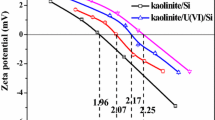Abstract
Detailed water-vapor sorption measurements were made on Li, ISTa, K, Cs and Mg kaolinite at 25°C. When desorption is started from P/P0 near saturation, all ionic modifications show reversible hysteresis. The size and P/P0 range of the hysteresis loop varies with the nature of the exchangeable ion and sample history.
No hysteresis occurs on Li and K kaolinite when desorption is started at P/P0 < 0.8 which along with other data indicates that Li and K exchangeable ions are not truly hydrated below P/P0 = 0.8. The hysteresis for all ionic modifications is traced to hydration of the exchangeable ions. The apparent anomalous position of Li and K ionic hydration is attributed to control of hydration of exchangeable ions by the difference between the hydration energy of the ion minus the specific adsorption energy of the ion for the clay. This difference must be positive before true ionic hydration occurs.
A molecular model for sorption is postulated in which sorption is assumed to take place at specific sorption sites upon the clay surface. The energy of sorption at different sites is believed to be different and also to be a function of the hydration state of the exchangeable ion. By the use of the proposed model and the detailed sorption data, hydration of the different exchangeable ions as a function of the relative vapor pressure can be obtained. The sorption model also predicts phase changes in the sorbed film at certain relative pressures. These calculated phase changes agree very well with phase changes indicated from Jura-Harkins’ plots of the experimental data.
Similar content being viewed by others
References
Bangham, D. H. (1944) Thermodynamics of sorption isotherms; the hysteresis loop in capillary condensation: Nature, Lond. v. 154, pp. 837–838
Bates, T. P. and Comer, J. J. (1955) Electron microscopy of clay surfaces: in Clays and Clay Minerals, Natl. Acad. Sci.-Natl. Res. Council, pub. 395, pp. 1–25
Brunauer, S. (1945) The Adsorption of Gases and Vapors, vol. 1: Princeton University Press, Princeton, 511 pp., p. 394.
Jura G. and Harkins, W. D. (1946) Surfaces of solids; XIV: J. Amer. Chem. Soc., v. 68, pp. 1941–1952
Keenan, A. G., Mooney, R. W. and Wood, L. A. (1951) The relation between exchangeable ions and water adsorption on kaolinite: J. Phys. & Colloid Chem., v. 55, pp. 1462–1474.
Martin, R. T. (1957) Water-vapor sorption on lithium kaolinite: in Clays and Clay Minerals, Natl. Acad. Sci.-Natl. Res. Council, pub. 566, pp. 23–38
Orchiston, H. D. (1954) Adsorption of water vapor; II, clays at 25°C: Soil Sci., v. 78, pp. 463–480
Woodward, L. A. (1955) Variations in viscosity of clay-water suspensions of Georgia kaolins: in Clays and Clay Minerals, Natl. Acad. Sci.-Natl. Res. Council, pub. 395, pp. 246–259
Author information
Authors and Affiliations
Rights and permissions
About this article
Cite this article
Martin, R.T. Water-Vapor Sorption on Kaolinite: Hysteresis. Clays Clay Miner. 6, 259–278 (1957). https://doi.org/10.1346/CCMN.1957.0060120
Published:
Issue Date:
DOI: https://doi.org/10.1346/CCMN.1957.0060120



